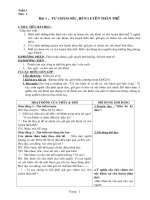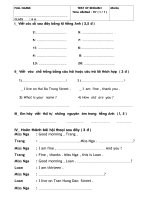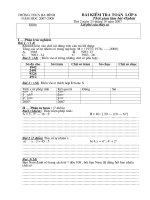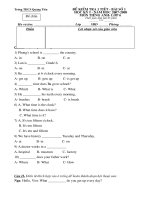6 imaging tutorial 1
Bạn đang xem bản rút gọn của tài liệu. Xem và tải ngay bản đầy đủ của tài liệu tại đây (1.85 MB, 11 trang )
Tutorial:
Imaging
in
the
ICU
Ben deBoisblanc, MD, FCCP & Trish Kritek, MD, FCCP
© 2014 American College of Chest Physicians
A 50 y/o woman presented to the ED with septic shock. She was given empiric
antibiotics, insulin and IV fluids. Due to her obesity, a left subclavian venous catheter
was placed using landmarks without ultrasound. Norepinephrine is infusing through the
catheter. The above x-ray was obtained on admission to the ICU. Which of the following
should be done now:
a) pull back the central venous catheter 2 cm
b) remove the catheter since it is in the aorta
c) advance the catheter 3 cm
d) leave the catheter alone and continue to use it
e) place a chest tube in the left hemithorax
© 2014 American College of Chest Physicians
A 65 y/o woman was admitted to the ICU with acute pulmonary edema following a STEMI.
She was intubated & had a PICC placed in the left arm. This chest x-ray was obtained on
admission. Dark blood can be aspirated from the PICC & it was visualized within the
axillary vein on U/S. Which of the following should be done now:
a) Place a chest tube in the left pleural space
b) Check an arterial blood gas on the blood aspirated from the PICC
c) Pull back the ETT 5 cm cm
d) Connect the PICC to a pressure transducer
e) Perform CPT on the left hemithorax with the patient in a right lateral decubitus
position
© 2014 American College of Chest Physicians
The above M-mode thoracic ultrasound image was obtained at the right posterior T9
intercostal in a proned 25 y/o man with ARDS due to H1N1 influenza. The findings in this
image:
a) exclude pneumothorax with a high level of certainty
b) are diagnostic of pneumothorax
c) demonstrate a densely consolidated right lover lobe
d) should be confirmed with a chest CT
e) demonstrate a large pleural effusion adjacent to normally aerated lung
© 2014 American College of Chest Physicians
A 45 year old woman with metastatic breast cancer was admitted to the ICU with
progressive shortness of breath over 1 week. Her blood pressure is 85/40 & neck veins
are distended. A screen capture of a parasternal short-axis echocardiogram is shown.
Appropriate next steps should include:
a) right-sided EKG leads
b) dobutamine
c) pericardiocentesis
d) thoracentesis
e) anticoagulation
© 2014 American College of Chest Physicians
A 49 y/o alcoholic man was admitted to the ICU with severe abdominal pain 3 days after
ingesting raw oysters. Both his hypotension and oliguria have responded to fluid
boluses. Blood cultures are growing a gram-negative rod. He is currently receiving a
carbapenem and vancomycin. A CT scan of his abdomen is shown. The next step in his
management should be:
a) add empiric doycycline
b) percutaneous transhepatic biliary drainage
c) therapeutic colonoscopy
d) surgery
e) metachlopromide
© 2014 American College of Chest Physicians
A 32 y/o gravid woman (gestational age 32 wks) is admitted to the ICU with headache,
nausea & visual disturbances. Her BP is 220/110. Creatinine is 3 mg/dl. Shortly after
admission she has a generalized tonic-clonic seizure. T2 weighted MRI of the brain is
shown above. True statements about this condition include:
a) blood pressure reduction increases the risk of brain herniation
b) low magnesium is a risk factor
c) focal neurologic signs are common
d) there is a predilection for younger patients
e) aneurisms are found in 40%
© 2014 American College of Chest Physicians
A 38 y/o HIV-infected man was admitted to the ICU 5 days ago with acute respiratory
failure due to PJP. His fever has persisted in spite of high dose TMP/SMX. He now has
RUQ tenderness. He is normotensive and he has adequate urine output. Correct
management at this time should include:
a) operative cholecystectomy
b) addition of vancomycin for enterococcal cholecystitis
c) percutaneous transhepatic biliary drainage
d) emergent ERCP with ampulotomy
e) ursodeoxycholic acid
© 2014 American College of Chest Physicians
A 60 y/o man developed nausea and vomiting after 4 hours eating potato salad at a
crawfish boil. Eight hours later he presented to the ED with extreme prostration. BP
70/40, P 130, RR 38, SpO2 85%. A chest x-ray in the ED is shown. Treatment of this
condition is focused on:
a) low tidal volume ventilation
b) tube thoracostomy
c) open surgical drainage
d) NG tube drainage
e) oral vacomycin
© 2014 American College of Chest Physicians
A 22 y/o HIV-positive woman with ARDS due to PJP had a CT scan performed for the
evaluation of hypoxemia. The pathogenesis of her pneumomediastinum and left
pneumothorax are most likely related to:
a) ruptured visceral pleura with followed by tracking into the mediastinum
b) esophageal rupture from her NG tube
c) misplaced central venous catheter
d) development of interstitial emphysema
e) ruptured intra-abdominal viscous
© 2014 American College of Chest Physicians
34 y/o restrained driver in a head on collision. Awake but remains hypotensive after 4 L
of crystalloid & 3 units PRBC in the ED. Based on the image above, you would
recommend:
a) emergent left posterolateral thoracotomy
b) esophagram
c) tranexamic acid
d) CT scan of abdomen & pelvis
e) Measurement of bladder pressure
© 2014 American College of Chest Physicians









